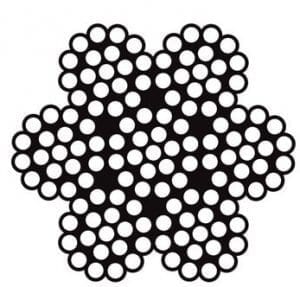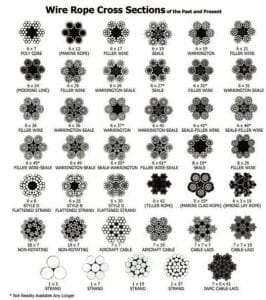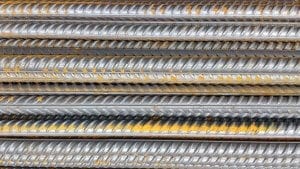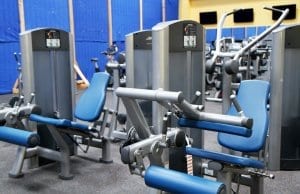Wire rope, a seemingly simple piece of lifting equipment, is actually one of the most widely used products around the world in relation to the sheer number of uses and applications that it has. This Blog looks at technical wire-rope information and guidance for your convenience.
Although many may not realise this, it is highly likely that this piece of equipment will have played some part in your life every single day, whether it's to form the cabling that allows you to make phone calls, or because it helped to complete the construction of the transport that you use.
 A reel of wire rope
A reel of wire rope
Given the comprehensive nature of this equipment, we thought that it was only appropriate that it deserves its own comprehensive guide to match. This detailed and extensive white paper is suitable to both those who want to learn more on the equipment, or those that are looking for more in-depth wire-rope information to expand their knowledge.
We have broken the wire-rope information guide down into two sections; technical wire-rope information and a guidance section. Within these sections you will find subsections, listing all kinds of information from how wire rope is formed, the different types of rope available, how to get the best use out of your equipment and more.
Why do we need wire rope?
Before moving on to the technical wire-rope information and guidance section, it is useful to spell out just why it is so useful.
This may not come as a surprise, but
wire rope has its history rooted in traditional rope, which itself has a history that
dates back to around 12,000BC. It's safe to say that the modern form that is used today is hugely different to that which was used in ancient times.
However, it's useful to be able to trace its history back, because we can see clear periods in the past where new technologies and innovations have led to the advancement and development of rope into the equipment that we use today.
The piece that is utilised in the modern era has remained largely the same since its discovery in 1824 by a mining engineer named
W.A.J Albert. Although it has, of course, changed over the years, the basic concept remains similar.
Albert invented wire rope as a sturdier, stronger and more robust alternative to many of the other forms of lifting mediums that were currently on the market. At the time, steel chains were being used, but should one of the steel links break, the whole chain became useless.
Although first developed as a stronger lifting medium, it now has many other uses thanks to its wide ranging benefits. You'll find its benefits and uses discussed in greater length below.
Technical wire-rope information
What is wire rope?
It is essentially constructed from several different parts, and isn't formed just like 'rope' as we are traditionally used to. Several metal wires are twisted together in a helix fashion to create a strand. This is done several times to create six or more strands. These strands are then themselves wrapped together, in a similar helix fashion, around a strong internal core, traditionally fibre or steel.
 This is what the internal structure of the equipment looks like
This is what the internal structure of the equipment looks like
Stainless steel or alloy steel are the most common metals that are used for manufacture, thanks to the benefits that they provide. Again, for more on the benefits of this, refer to our benefits section below.
Here we will break down the three separate sections of what forms this equipment:
Core
This is the strong internal core around which all of the wires and strands are wrapped around. It is designed to provide support to these wires and strands, as well as to maintain their position during any operation.
Fibre cores help to provide great flexibility, and they are also lubricated too, meaning that internal lubrication helps to reduce friction and corrosion.
You will also see steel cores on the market too, and these are great at providing high levels of strength, as well as a strong resistance to crushing, heat and distortion.
Strands
Strands are created by wrapping multiple wires together, typically between 3 and 91 wires. The more wires that are used to create a strand, the more flexible both this strand, and the final product in general, will be.
Wires
Each individual piece of metal (often also called a rod) is a wire, helping to make up the strands.
Lays
You will find that wire rope can be laid in a variety of different ways, and we have covered more on this below. A 'lay' refers to the way in which the wires and strands have been placed during the manufacturing process.
The first two sections refer to the way in which the wires are laid, while the second two sections refer to the way in which the strands are laid.
A regular or ordinary hand lay (wires)
This type of lay is where the wires in each strand are laid out in an opposite direction to the direction of the strand. You will find that the top of the wires seems to run parallel to the axis of the rope.
This type of lay makes the rope more kink resistant, as well as making it less likely to untwist. It is also much easier to handle, and has a higher level of resistance to crushing than a langs lay, which we have referred to below.
Although this is the most common type of lay, you will find the only drawback is that it has poor wearing qualities due to where the crown wires contact the strand.
Langs lay (wires)
A langs lay is the complete opposite to a regular or ordinary hand lay, and instead has the wires in the strand running in the same direction as the strand itself. The crown of the metal wires are laid at an angle to the axis of the rope as opposed to running parallel.
This type of lay gives the rope a greater length, meaning that abrasion and surface pressure is reduced. It is also more flexible and resistant to fatigue. However, as it is a direct opposite to the type of lay above, some of its drawbacks are where the above finds advantages. This type of lay is more likely to kink or untwist, and so is most commonly used in situations where the load being lifted is not at risk of rotating.
A langs lay is still an incredibly useful type of lay, and is often used for construction, excavating and mining due to the increased level of flexibility.
Right hand lay (strands)
The most common type of lay, where the strands go from left to right around the central core.
Left hand lay (strands)
As the direct opposite to the above, this is where the strands pass from right to left around the core. This type of lay is most often used for special applications such as for cable tool drilling lines.
A sizing guide
You will see that when shopping for wire rope, there will be two numbers next to each piece. This is a sizing guide that is used worldwide, so the numbers will mean the same wherever you shop.
For example, we stock 6 x 19 wire. The first number, 6, refers to the number of strands contained in a wire rope. The second number, 19, refers to how many metal wires are in each strand.
 Some of the different types of wire rope constructions available
Some of the different types of wire rope constructions available
The most popular types that we sell are:
- 19 x 7
- 6 x 36
- 6 x 19
- 7 x 19
- 1 x 19
- 7 x 7
As well as coming in a variety of different wires and strands, you will also find that wire rope comes in various diameters too. This can range from 2cm to 13cm, or more, and will entirely depend on the application that you need to use it for.
How is wire rope made?
Interested to know how this tool is constructed? This wire-rope information section contains everything you need to know.
Firstly, using machines, the metal wires are woven together to form the strands. This is done by loading the wire onto a stranding machine, which more or less works as a giant winder. As the wires are being twisted, they are converged in a dye, which is what helps to form them to the required diameter.
At the same time, the wires are also being lubricated, not only to help them move through the dye more smoothly, but also to provide a higher quality product for use. (We've written more on this below.)
The wires now exit the machine as one compact and lubricated strand. The strand is run through a large rubber band, which helps to trim any excess lubrication off of the surface, and is then run through a row of straightening rollers.
These rollers exert a heavy amount of pressure onto the strands, which prevents them from unravelling due to the twisting process that they went through previously.
For more information and a visual demonstration of how wire rope is made, please visit
How It's Made - Industrial Wire Ropes.
The benefits and advantages of wire rope
Now that we've covered the manufacturing process, it would be useful to briefly examine the advantages and benefits that it provides to its users.
Strength
Wire rope is designed to be extremely strong and reliable. Not only does the sturdy inner core and strong metal provide strength, but as there are several strands involved, an operation isn't reliant on one strand alone.
This is a big advantage over products which have relied on the use of steel chains. Although chains are incredibly reliable, should one chain break then the whole chain becomes completely unworkable. This is the reason that Albert, as referred to above, sought an alternative.
Cost-effective
Although the manufacturing process can make it seem that this tool incurs a high cost, wire rope is actually a highly cost-effective solution for businesses.
High resistance
Thanks to the metal used and the lubrication, wire rope has a high level of resistance to corrosion, as well as both hot and cold temperatures.
 With a high resistance to corrosion and rust, so you won't be seeing this!
With a high resistance to corrosion and rust, so you won't be seeing this!
It is also abrasion resistant too, although it is still likely to suffer some damage after continued and constant use. This is why regular lubrication is so important, as well as inspections. This has been covered in the section below.
The different types of wire rope
There are many types available, each designed with a specific purpose in mind. We stock several of these types, and you can find out more on each one by following the links below.
 Gym cables are what operate the machines we use at fitness centres
Gym cables are what operate the machines we use at fitness centres
Guidance on correct usage
Now that we've covered some of the comprehensive technical details, we wanted to offer some brief guidance on safe usage. You can read more on the guidelines under the
Lifting Operations and Lifting Equipment Regulations 1998 (LOLER) and
Lifting equipment at work.
Using wire rope safely
To ensure that you use it safely, all staff will need to undergo proper training. Only competent persons are allowed to work with lifting equipment and to plan lifting operations.
Any staff that are working with the wire rope will need to be fully aware of its lifting capabilities, as each piece of equipment can only handle a certain load weightage, known as the safe working load (SWL).
Please carry out a full risk assessment before conducting any lifting operation. Again, this risk assessment must be carried out by a competent person.
Maintaining the quality of your wire rope
To maintain quality, there are certain factors that you must consider.
Inspections
You must regularly inspect and test your wire rope to ensure that it is safe to use. Depending on the type of equipment you have, the length of time between each required inspection changes, so please speak with your manufacturer for this information.
However, we would recommend inspections before each new lifting operation. A thorough inspection needs to be conducted, as it may be that there is an internal problem that may not be so obvious at first.
Although wire rope is built to be extremely long lasting, problems can happen, so it's important that this is taken seriously. If you do notice any damages, please stop using it and get in contact with us immediately.
You must have your wire rope inspected by professionals at regular intervals so that you can be provided with a certification labelling its continued safe usage.
Storage
It is crucial that you store your equipment in conditions that will ensure its long-lasting life is prolonged even further. For example, never store wire rope in conditions with moisture in the air.
For a full list of recommendations on how to safely store wire rope, please refer to the section at the
bottom of this page.
Lubrication
Your wire rope will come with some level of lubrication already and we've covered it to a degree in this white paper, but please make sure that you regularly lubricate your equipment. This will help protect it against any friction and abrasion, as well as protecting the load that it is working with.
What industries can wire rope be used for?
As we previously mentioned, wire rope has an almost limitless number of uses,
helping to serve dozens of industries around the world. These are just some of the industries which make use of it:
- Construction and engineering for use with cranes
- Aerospace and automotive for help on the production lines
- Marine for strong shipping cabling
- Food and breweries, also for the production lines
- Warehousing for help with the storage of items
- Mining and oil and gas for deep drilling
- Military for vibration isolators
 The construction industry is one of the heaviest users of wire rope
The construction industry is one of the heaviest users of wire rope
Find out more wire-rope information
As you can see from the above, wire rope is an incredibly complex piece of equipment, with a detailed history and, given the usefulness for so many industries, most likely a detailed future too.
We hope that the wire-rope information guide above has provided you with everything that you need to know when it comes to this piece of lifting equipment, and that you have been able to find any information or answers to questions that you have been looking for.
Should you have further questions, or are perhaps looking to source some equipment for your own business, then we are ready to help. Please give one of our team a call on 01384 78004, or get in contact with us via our
support page here.
You can also view more on our products by visiting
our YouTube channel here.
 A reel of wire rope
Given the comprehensive nature of this equipment, we thought that it was only appropriate that it deserves its own comprehensive guide to match. This detailed and extensive white paper is suitable to both those who want to learn more on the equipment, or those that are looking for more in-depth wire-rope information to expand their knowledge.
We have broken the wire-rope information guide down into two sections; technical wire-rope information and a guidance section. Within these sections you will find subsections, listing all kinds of information from how wire rope is formed, the different types of rope available, how to get the best use out of your equipment and more.
A reel of wire rope
Given the comprehensive nature of this equipment, we thought that it was only appropriate that it deserves its own comprehensive guide to match. This detailed and extensive white paper is suitable to both those who want to learn more on the equipment, or those that are looking for more in-depth wire-rope information to expand their knowledge.
We have broken the wire-rope information guide down into two sections; technical wire-rope information and a guidance section. Within these sections you will find subsections, listing all kinds of information from how wire rope is formed, the different types of rope available, how to get the best use out of your equipment and more.
 This is what the internal structure of the equipment looks like
Stainless steel or alloy steel are the most common metals that are used for manufacture, thanks to the benefits that they provide. Again, for more on the benefits of this, refer to our benefits section below.
Here we will break down the three separate sections of what forms this equipment:
This is what the internal structure of the equipment looks like
Stainless steel or alloy steel are the most common metals that are used for manufacture, thanks to the benefits that they provide. Again, for more on the benefits of this, refer to our benefits section below.
Here we will break down the three separate sections of what forms this equipment:
 Some of the different types of wire rope constructions available
The most popular types that we sell are:
Some of the different types of wire rope constructions available
The most popular types that we sell are:
 With a high resistance to corrosion and rust, so you won't be seeing this!
It is also abrasion resistant too, although it is still likely to suffer some damage after continued and constant use. This is why regular lubrication is so important, as well as inspections. This has been covered in the section below.
With a high resistance to corrosion and rust, so you won't be seeing this!
It is also abrasion resistant too, although it is still likely to suffer some damage after continued and constant use. This is why regular lubrication is so important, as well as inspections. This has been covered in the section below.
 Gym cables are what operate the machines we use at fitness centres
Gym cables are what operate the machines we use at fitness centres
 The construction industry is one of the heaviest users of wire rope
The construction industry is one of the heaviest users of wire rope